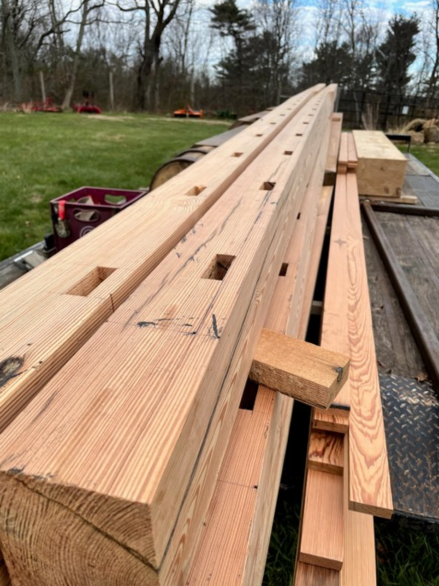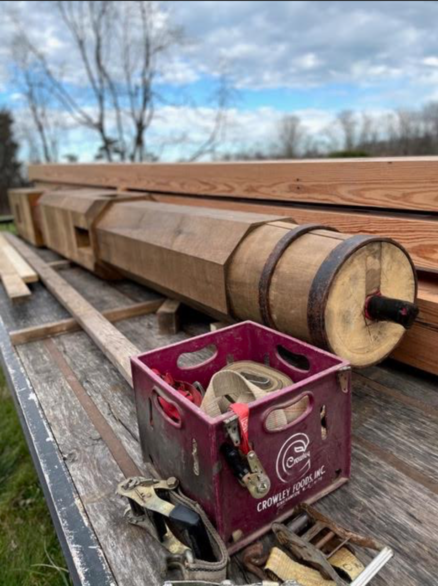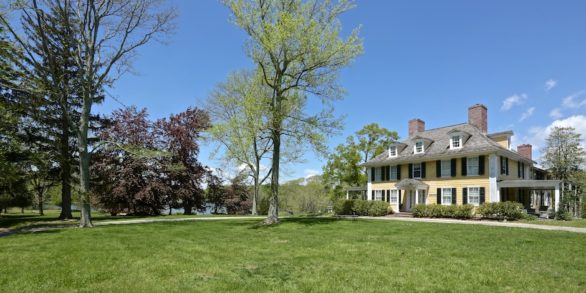
HISTORIC WINDMILL RESTORATION CONTINUES
19th Century Windmill Gets 21st Century Update
——————-
After three years of ongoing fundraising and work, a new windshaft and blades are being installed in the 1810 Dominy Windmill at Sylvester Manor. Master Craftsman Jim Kricker and his team of millwrights from Saugerties, NY, arrived on Shelter Island on December 3 and will be on site for the next three weeks working to complete Stage 3 of the windmill restoration and preservation project.
During setup on the first day, Kricker described the process: “What we are doing here is removing the old windshaft first and then we will remove the old neck bearing. We will explore the beam under the neck bearing and are prepared to replace it if need be. Once that is done, the new windshaft goes in. The sails are made up of 6 pieces total. The backbone is made up of stocks. Two pieces go through the mortices of the windshaft to form a cross. The whips are the remaining 4 pieces that have lattice attached. Once assembled, they will be bolted to the stocks. Then, we will have an intact windmill, without the cloths. The cloths are part of this phase, but have not been made yet.”

We anticipate proceeding with Phase 4, which includes bringing the windmill back to operational condition, in Spring/Summer 2021. This will address the mechanical parts of the windmill and related structural issues associated with supporting, aligning and operating the machinery.

Phase 1 and 2 were completed over the past two years. Phase 1 included stabilizing the foundation by lifting the 6,000 pound structure up six feet from its resting place for the first time in nearly 100 years in order to rebuild the foundation. New piers were poured and strapped to the undermounts, ensuring the mill would be secure and stable. Phase 2 focused on the exterior where the shingles on the mill had eroded and cracked and the doors and windows had deteriorated. The mill was completely re-shingled, and new doors and windows installed.
The Sylvester Manor windmill was originally built in Southold, New York, in 1810 by the renowned carpenter and millwright, Nathaniel Dominy V (1770-1852). As a fifth generation craftsman, Dominy worked on both the North and South Forks and had gained his reputation as a Master Carpenter after building the Hook Mill in East Hampton, New York in 1806. The Sylvester Manor mill was commissioned by partners Benjamin Horton, Moses Cleveland, Joseph Hallock and Barnabas Case several years later and originally operated in Southold grinding bushels of wheat, corn, rye and meslin.
In 1840 the mill was purchased by Joseph Congdon and moved to Shelter Island where it stood in the center of town near the present library. The new mill replaced a previous Shelter Island mill that had burned down years earlier. In 1855, the windmill was sold again to Smith Baldwin who continued to operate it until the 1870s. In 1879, Lilian Horsford, a descendant of Sylvester Manor, bought the mill to preserve it as an historic landmark.
~~~~~~~~~~~~~~~~~~~~~


~~~~~~~~~~~~~~~~~~~~~
The windmill resumed operation during World War I to help provide meal and flour to the inhabitants of Shelter Island at a time of severe food shortages. Cornelia Horsford, the youngest sister of Lilian, purchased the windmill from her in 1926 and had it moved to the highest elevation of Sylvester Manor, where it sits today.
In 1952, Sylvester Manor owner Andrew Fiske renovated the windmill replacing the shingles and main driveshaft, but it was damaged soon after in a hurricane; it has been without the blades ever since.
—————–
This windmill is one of 11 surviving 18th and 19th century wind-powered gristmills on Long Island.
~~~~~~~~~~~~~~~~~~~~~~~~~~~~~~~

About Sylvester Manor Educational Farm: Once a Native American hunting, fishing and farming ground, Sylvester Manor has since 1651 been home to eleven generations of its original European settler family. Gifted to the Shelter Island community in 2014, the 235-acre historic site is the most intact slaveholding plantation remnant north of Virginia. Sylvester Manor sits on Gardiners Creek and has been transformed to an Enlightenment-era farm, then to a pioneering food industrialist’s estate and today to a nonprofit organic educational farm and vibrant arts and education center with programs open to all. The property includes the original Manor House built in 1735, a timber frame farmstand and a 19th century windmill. For more information, visit www.sylvestermanor.org.

www.sylvestermanor.org
—————-
=====================================

AAQ / Resource: Araiys Design Landscape Architects
____________________________________________________________________
